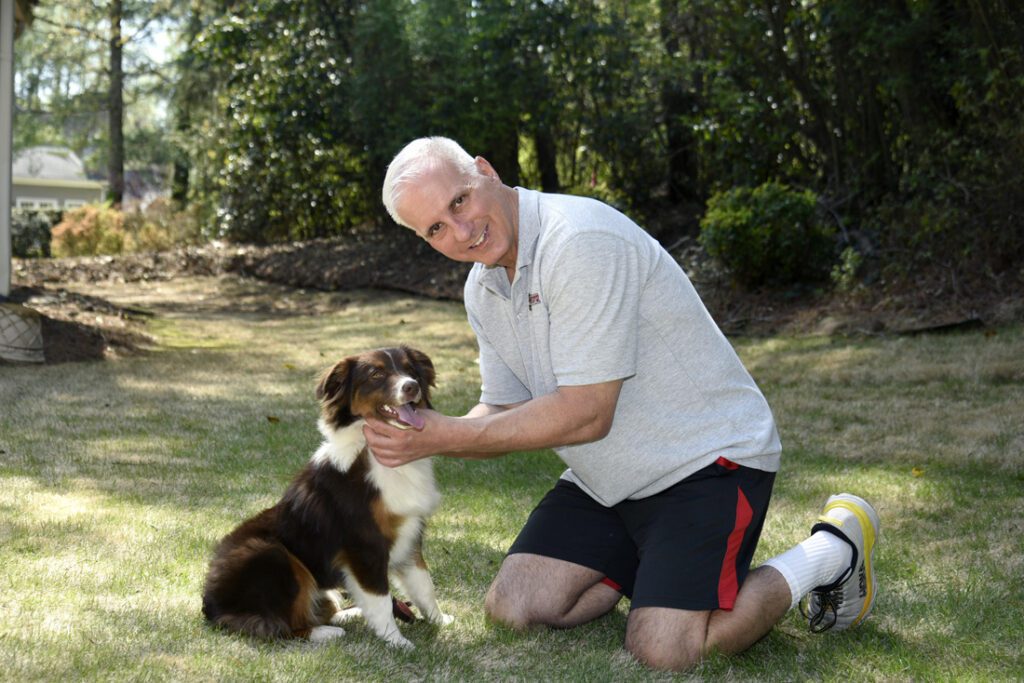Caring for dogs and cats with PTS.

Have you ever heard the theory that pets can look like their owners? In the same vein, they can also suffer from post-traumatic stress disorder just like humans. According to Mark Spivak, head trainer at Sandy Springs-based Comprehensive Pet Therapy, dog and cat brains are structurally similar to human brains with the same neurotransmitters. “Their brains and ultimately their emotional state and behavior can be negatively impacted by acute or chronic traumatic experiences whereby they may subsequently develop PTSD,” he says.
Origins of Pet PTSD
The reasons behind this condition can include chronic neglect or abuse by an owner, bullying from another animal in the household or an attack. Spivak says CPT has also treated animals who developed PTSD after observing damage to their home during a tornado and that experienced long exposure to loud alarm systems after a burglar entered while owners were away.
Symptoms & Signs
“Dogs and cats may both exhibit a symptom profile similar to humans with PTSD,” says Spivak, who adds that indicators include avoiding stimuli relevant to the traumatic event; becoming less confident, energetic and playful; and being more aloof. He says cats and dogs suffering from PTSD can also exhibit hypervigilance, anxiety, restlessness, insomnia, irritability, panic and/or aggression.
Care & Treatment
According to Spivak, treating pets with PTSD is a three-pronged approach. The first step is to reduce generalized anxiety through a mix of holistic, homeopathic, quality of life and nutritional solutions.
The second step is exposure therapy, which Spivak says is essentially teaching the pet to calmly tolerate progressively greater levels of stimulus exposure and to educate the animal to respond with productive coping behaviors.
“For example, instead of a pet escaping, avoiding or responding with aggressive posturing, we encourage it to calmly explore, focus attention on the owner or divert activity toward a game of fetch or tug,” Spivak says. “We may also counter condition, where we create an association between the stimulus and high-value food whereby the pet ultimately changes its perception of the stimulus from threatening to pleasant.”
The third step is stimulus management, which Spivak says can minimize the likelihood the cat or dog will observe exposure beyond his/her threshold level.
“If a client’s dog develops PTSD after an attack by a neighbor dog, we may walk the client’s dog in another area within the neighborhood or at least 50 feet from other dogs,” Spivak says. “We will maintain this minimum distance until the client’s dog handles all contacts with composure. Then, gradually, we will bring the dog closer, but only when it is ready.”
Cats may require less physical activity than dogs, but they may need to learn to wear a harness or leash for certain activities so they feel more secure and cannot escape during the desensitization drills. Other solutions for cats may include elevated “safe spots” in the home, as well as shifting litter box and/or feeding stations.
What You Can Do
To help a cat or dog suffering from PTSD, Spivak says the first step is to contact an organization like CPT so it can assist with designing and implementing a behavior modification program. “Successful resolution of PTSD will enhance the pleasure owners receive from their pet and will dramatically improve the pet’s quality of life,” Spivak says. “In cases of aggression, behavior modification will create a safer outcome for family members, the pet and other people and pets in the community.”
COMPREHENSIVE PET THERAPY
404.236.2150
cpt-training.com
STORY: Chelsie Butler
PHOTO: Joann Vitelli
Simply Buckhead is an upscale lifestyle magazine focused on the best and brightest individuals, businesses and events in Buckhead, Brookhaven, Sandy Springs, Dunwoody and Chamblee. With a commitment to journalistic excellence, the magazine serves as the authority on who to know, what to do and where to go in the community, and its surroundings.

















